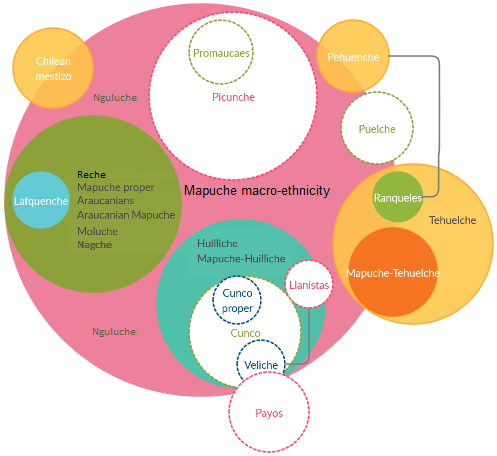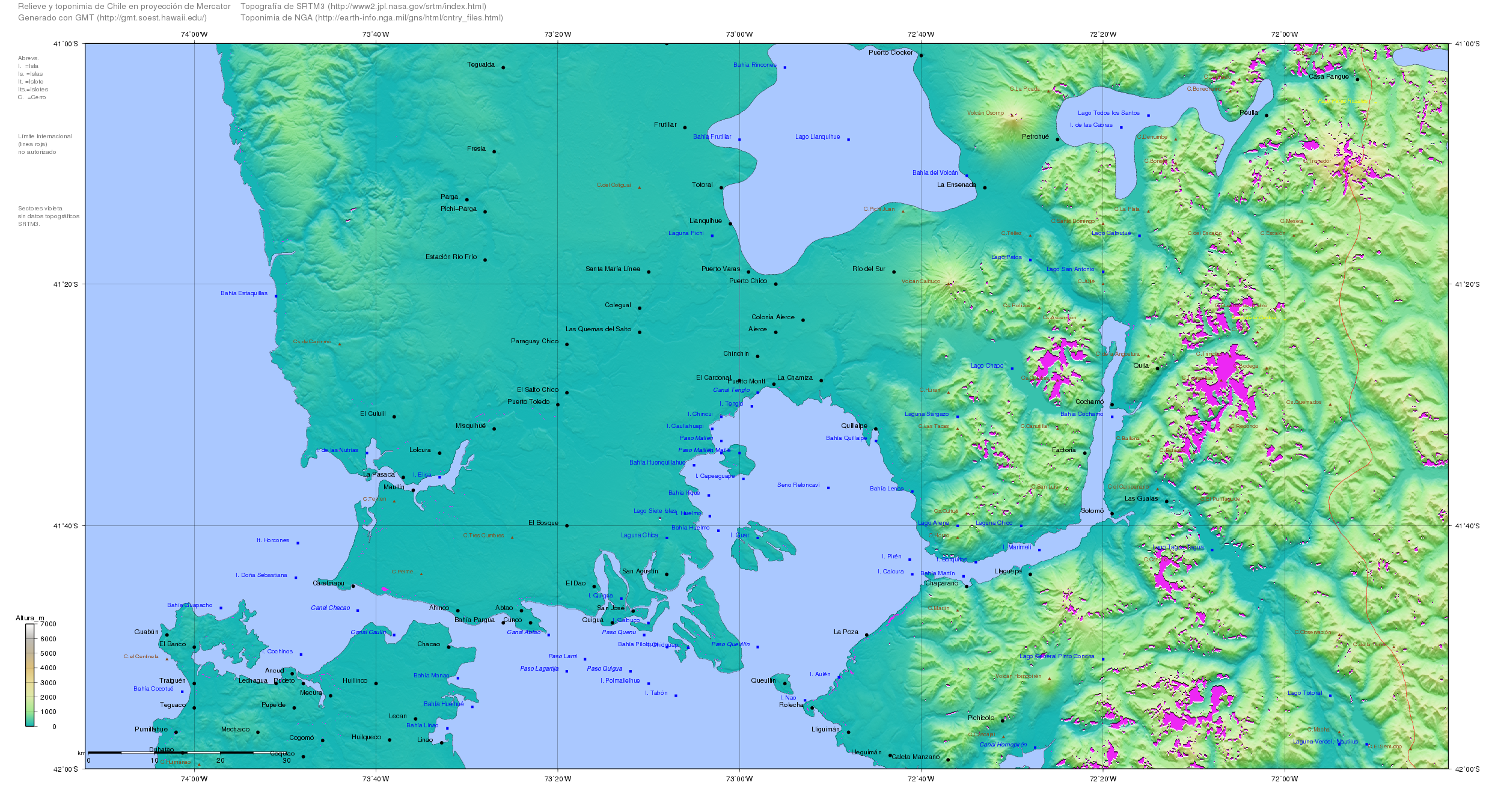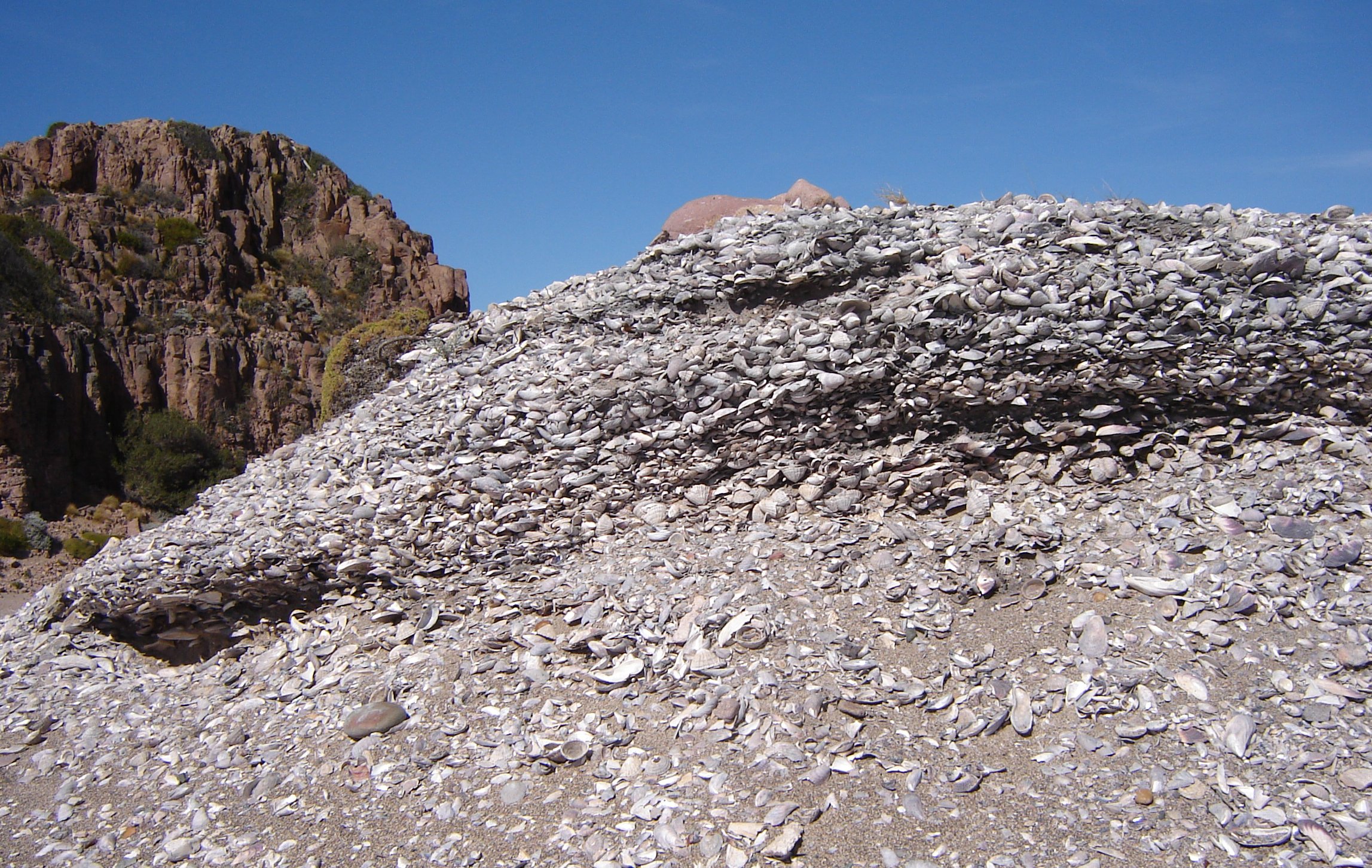|
Chono People
The Chono, or GuaitecoUrbina Burgos 2007, p. 334. were a nomadic indigenous people or group of peoples of the archipelagos of Chiloé, Guaitecas and Chonos. The Chono people lived as hunter-gatherers traveling by canoe. Much of what is known from Spanish sources on Chonos is filtered by a Huilliche worldview, as Huilliches and Huilliche language was used to communicate with Chonos. Physical appearance Together with other canoe-faring peoples of western Patagonia, the Chono people shared the physical features of being of low stature, being long-headed (dolichocephalic) and having a "low face". In the opinion of Robert FitzRoy who saw the Chono people in the 1830s, they were more muscular and with a more beautiful appearance when compared to canoe-farers further south.Trivero Rivera 2005, p. 42. Alberto Achacaz Walakial, himself a Kawésqar born around 1929, said that the Chono people were taller and of darker skin than his people. He also added that their noses and faces we ... [...More Info...] [...Related Items...] OR: [Wikipedia] [Google] [Baidu] |
Dalca (reconstrucción)
The dalca or piragua is a type of canoe employed by the Chonos, a nomadic indigenous people of southern Chile, and Huilliche people living in Chiloé archipelago. It was a light boat and ideal for navigating local waterways, including between islands of the Chiloé Archipelago, through the Chacao Channel to mainland Chile, and along the coast of the Gulf of Penas. Spanish chronicles called it best-suited for those waters, far superior to ships of the ''conquistadore''s. The dalca was essential for many activities in Chiloé Archipelago including the logging of alerce wood, the Circular Mission system, and the various expeditions to Nahuel Huapi Lake and the channels of Patagonia. By 1886 dalcas had been replaced by other boat types and were not longer in use in Chiloé. According to archaeologist José Miguel Ramírez, only full non-reconstructed dalcas remaining were collected by Swedish explorer Carl Skottsberg and are at the Museum of Ethnography, Stockholm and the Mus ... [...More Info...] [...Related Items...] OR: [Wikipedia] [Google] [Baidu] |
Joint
A joint or articulation (or articular surface) is the connection made between bones, ossicles, or other hard structures in the body which link an animal's skeletal system into a functional whole.Saladin, Ken. Anatomy & Physiology. 7th ed. McGraw-Hill Connect. Webp.274/ref> They are constructed to allow for different degrees and types of movement. Some joints, such as the knee, elbow, and shoulder, are self-lubricating, almost frictionless, and are able to withstand compression and maintain heavy loads while still executing smooth and precise movements. Other joints such as suture (joint), sutures between the bones of the skull permit very little movement (only during birth) in order to protect the brain and the sense organs. The connection between a tooth and the jawbone is also called a joint, and is described as a fibrous joint known as a gomphosis. Joints are classified both structurally and functionally. Joints play a vital role in the human body, contributing to movement, sta ... [...More Info...] [...Related Items...] OR: [Wikipedia] [Google] [Baidu] |
Mapuche
The Mapuche ( , ) also known as Araucanians are a group of Indigenous peoples of the Americas, Indigenous inhabitants of south-central Chile and southwestern Argentina, including parts of Patagonia. The collective term refers to a wide-ranging ethnicity composed of various groups who share a common social, religious, and economic structure, as well as a common linguistic heritage as Mapudungun speakers. Their homelands once extended from Choapa River, Choapa Valley to the Chiloé Archipelago and later spread eastward to Puelmapu, a land comprising part of the Pampas, Argentine pampa and Patagonia. Today the collective group makes up over 80% of the Indigenous peoples in Chile and about 9% of the total Chilean population. The Mapuche are concentrated in the Araucanía (historic region), Araucanía region. Many have migrated from rural areas to the cities of Santiago and Buenos Aires for economic opportunities, more than 92% of the Mapuches are from Chile. The Mapuche traditional e ... [...More Info...] [...Related Items...] OR: [Wikipedia] [Google] [Baidu] |
Pre-Columbian Era
In the history of the Americas, the pre-Columbian era, also known as the pre-contact era, or as the pre-Cabraline era specifically in Brazil, spans from the initial peopling of the Americas in the Upper Paleolithic to the onset of European colonization of the Americas, European colonization, which began with Christopher Columbus's voyage in 1492. This era encompasses the history of Indigenous peoples of the Americas, Indigenous cultures prior to significant European influence, which in some cases did not occur until decades or even centuries after Columbus's arrival. During the pre-Columbian era, many civilizations developed permanent settlements, cities, agricultural practices, civic and monumental architecture, major Earthworks (archaeology), earthworks, and Complex society, complex societal hierarchies. Some of these civilizations had declined by the time of the establishment of the first permanent European colonies, around the late 16th to early 17th centuries, and are know ... [...More Info...] [...Related Items...] OR: [Wikipedia] [Google] [Baidu] |
Chiloé Island
Chiloé Island (, , ), also known as Greater Island of Chiloé (''Isla Grande de Chiloé''), is the largest island of the Chiloé Archipelago off the west coast of Chile, in the Pacific Ocean. The island is located in southern Chile, in the Los Lagos Region. The island is roughly rectangular. Its southwestern half is a wilderness of contiguous forests and swamps. Mountains form a belt running from the northwestern to the southeastern corner of the island. Cordillera del Piuchén make up the northern mountains and the more subdued Cordillera de Pirulil gathers the southern mountains. The landscape of the northeastern sectors of Chiloé Island is dominated by rolling hills with a mosaic of pastures, forests and cultivated fields. While the western shores are rocky and relatively straight, the eastern and northern shores contain many inlets, bays and peninsulas, and it is here where all towns and cities lie. Geographically, the bulk of the island is a continuation of the Chilean C ... [...More Info...] [...Related Items...] OR: [Wikipedia] [Google] [Baidu] |
Cunco People
Cuncos, Juncos or Cunches is a poorly known subgroup of Huilliche people native to coastal areas of southern Chile and the nearby hinterland. Mostly a historic term, Cuncos are chiefly known for their long-running conflict with the Spanish during the colonial era of Chilean history. Cuncos cultivated maize, potatoes and quinoa and raised chilihueques.Urbina 2009, p. 44. Their economy was complemented by travels during spring and summer to the coast where they gathered shellfish and hunted sea lions. They were said to live in large rukas.Alcamán 1997, p. 32. Cuncos were organized in small local chiefdoms forming a complex system of intermarried families or clans with local allegiance.Alcamán 1997, p. 47. Ethnicity and identity The details of the identity of the Cuncos is not fully clear. José Bengoa defines "Cunco" as a category of Indigenous Mapuche-Huilliche people in southern Chile used by the Spanish in colonial times.Bengoa 2000, p. 122. The Spanish referred ... [...More Info...] [...Related Items...] OR: [Wikipedia] [Google] [Baidu] |
Mapudungun
Mapuche ( , ; from 'land' and 'people', meaning 'the people of the land') or Mapudungun (from 'land' and 'speak, speech', meaning 'the speech of the land'; also spelled Mapuzugun and Mapudungu) is either a language isolate or member of the small Araucanian family related to Huilliche spoken in south-central Chile and west-central Argentina by the Mapuche people. It was formerly known as Araucanian, the name given to the Mapuche by the Spanish; the Mapuche avoid it as a remnant of Spanish colonialism. Mapudungun is not an official language of Chile and Argentina, having received virtually no government support throughout its history. However, since 2013, Mapuche, along with Spanish, has been granted the status of an official language by the local government of Galvarino, one of the many communes of Chile. It is not used as a language of instruction in either country's educational system despite the Chilean government's commitment to provide full access to education in Mapu ... [...More Info...] [...Related Items...] OR: [Wikipedia] [Google] [Baidu] |
Conquest Of Chile
The Conquest of Chile is a period in Chilean history that starts with the arrival of Pedro de Valdivia to Chile in 1541 and ends with the death of Martín García Óñez de Loyola in the Battle of Curalaba in 1598, and the subsequent destruction of the Seven Cities in 1598–1604 in the Araucanía region. This was the period of Spanish conquest of territories, founding of cities, establishment of the Captaincy General of Chile, and defeats ending its further colonial expansion southwards. The initial conflict with the Mapuche extended well beyond the conquest period becoming known as the Arauco War, and the Spanish were never able to reassert control in Araucanía south of the Bío Bío River. Spanish conquerors entering Chile were accompanied by thousands of yanakuna from the already subdued territories of the Inca Empire as well by a few African slaves. In the first years of the period the Spanish in Chile gained a reputation of being poorly dressed among the Spanish in Per ... [...More Info...] [...Related Items...] OR: [Wikipedia] [Google] [Baidu] |
Midden
A midden is an old dump for domestic waste. It may consist of animal bones, human excrement, botanical material, mollusc shells, potsherds, lithics (especially debitage), and other artifacts and ecofacts associated with past human occupation. These features provide a useful resource for archaeologists who wish to study the diets and habits of past societies. Middens with damp, anaerobic conditions can even preserve organic remains in deposits as the debris of daily life are tossed on the pile. Each individual toss will contribute a different mix of materials depending upon the activity associated with that particular toss. During the course of deposition sedimentary material is deposited as well. Different mechanisms, from wind and water to animal digs, create a matrix which can also be analysed to provide seasonal and climatic information. In some middens individual dumps of material can be discerned and analysed. Shells A shell midden or shell mound is an arc ... [...More Info...] [...Related Items...] OR: [Wikipedia] [Google] [Baidu] |
Journal Of Latin American And Caribbean Anthropology
The American Anthropological Association (AAA) is an American organization of scholars and practitioners in the field of anthropology. With 10,000 members, the association, based in Arlington, Virginia, includes archaeologists, cultural anthropologists, biological (or physical) anthropologists, linguistic anthropologists, linguists, medical anthropologists and applied anthropologists in universities and colleges, research institutions, government agencies, museums, corporations and non-profits throughout the world. The AAA publishes more than 20 peer-reviewed scholarly journals, available in print and online through AnthroSource. The AAA was founded in 1902. History The first anthropological society in the US was the American Ethnological Society of New York, which was founded by Albert Gallatin and revived in 1899 by Franz Boas after a hiatus. 1879 saw the establishment of the Anthropological Society of Washington (which first published the journal ''American Anthropologist'', ... [...More Info...] [...Related Items...] OR: [Wikipedia] [Google] [Baidu] |
Ricardo E
Ricardo is the Spanish and Portuguese cognate of the name Richard. It derived from Proto-Germanic ''*rīks'' 'king, ruler' + ''*harduz'' 'hard, brave'. It may be a given name, or a surname. People Given name * Ricardo de Araújo Pereira (born 1974), Portuguese comedian *Ricardo Arjona (born 1964), Guatemalan singer *Ricardo Arona (born 1978), Brazilian mixed martial artist *Ricardo Ávila (born 1997), Panamanian footballer * Ricardo Bierhals (born 1990), Brazilian footballer * Ricardo Bralo (1916–?), Argentine long-distance runner * Ricardo Bombine Pimentel (born 1978), Brazilian musician * Ricardo Bueno Fernández (1940-2015), Spanish politician * Ricardo Busquets (born 1974), Puerto Rican swimmer *Ricardo Cardeno (born 1971), Colombian triathlete *Ricardo Carvalho (born 1978), Portuguese footballer *Ricardo Cortez (1900-1977), American actor * Ricardo Darín (born 1957), Argentine actor * Ricardo da Silva (born 1980), Cape Verdean-Portuguese footballer *Ricardo Esgaio, Portu ... [...More Info...] [...Related Items...] OR: [Wikipedia] [Google] [Baidu] |
Monte Verde
Monte Verde is a Paleolithic archaeological site in the Llanquihue Province in southern Chile, located near Puerto Montt, Los Lagos Region. The site is primarily known for Monte Verde II, dating to approximately 14,550–14,500 calibrated years Before Present (BP). The Monte Verde II site has been considered key evidence showing that the human settlement of the Americas pre-dates the Clovis culture by at least 1,000 years. This contradicts the previously accepted "Clovis first" model which holds that settlement of the Americas began after 13,500 cal BP. The Monte Verde findings were initially dismissed by most of the scientific community, but the evidence then became more accepted in archaeological circles. The site also contains an older, much more controversial layer (Monte Verde I) suggested to date to 18,500 cal BP (16,500 BC), that lacks the general acceptance of Monte Verde II. Monte Verde II represents a campsite with wooden tent-like structures that was later covered b ... [...More Info...] [...Related Items...] OR: [Wikipedia] [Google] [Baidu] |







